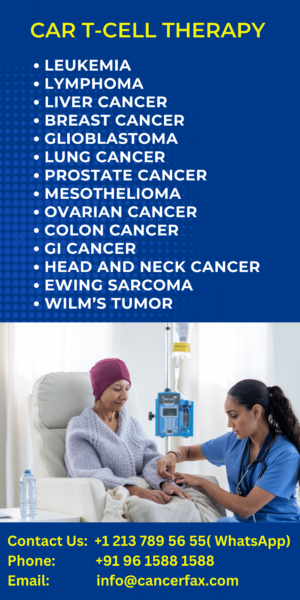Lymphoma
What is lymphoma?
Lymphoma is a type of cancer that affects the lymphatic system, which is a part of the body’s germ-fighting mechanism. Lymph nodes (lymph glands), spleen, thymus gland, and bone marrow are all part of the lymphatic system. All of these locations, as well as other organs throughout the body, can be affected by lymphoma.
Lymphoma comes in a variety of forms. The following are the main subtypes:
Hodgkin’s lymphoma (also known as Hodgkin’s disease) is a type of lymphoma.
Non-lymphoma Hodgkin’s (NHL) is a type of cancer that affects the lymphatic system.
The optimal lymphoma treatment for you is determined on the type and severity of your lymphoma. Chemotherapy, immunotherapy medicines, radiation therapy, a bone marrow transplant, or a combination of these treatments may be used to treat lymphoma.
Symptoms of lymphoma
Signs and symptoms of lymphoma may include:
- Painless swelling of lymph nodes in your neck, armpits or groin
- Persistent fatigue
- Fever
- Night sweats
- Shortness of breath
- Unexplained weight loss
- Itchy skin
Causes of lymphoma
Lymphoma is caused by an unknown factor, according to doctors. But it all starts with a genetic mutation in a disease-fighting white blood cell called a lymphocyte. The mutation causes the cell to grow quickly, resulting in a large number of sick lymphocytes that continue to multiply.
The mutation also allows the cells to survive when other cells would normally die. This results in an overabundance of defective and inefficient lymphocytes in your lymph nodes, causing swelling in the lymph nodes, spleen, and liver.
Risk factors
Lymphoma can be caused by a number of factors, including:
Age: Some lymphoma kinds are more common in young individuals, whereas others are diagnosed more frequently in persons over 55.
Male: Males are somewhat more likely than females to get lymphoma.
Immune system: Lymphoma is more likely in those who have immune system illnesses or who take immune-suppressing medications.
Infections: The Epstein-Barr virus and Helicobacter pylori infection, for example, are linked to an increased risk of lymphoma.
Diagnosis of lymphoma
Lymphoma is diagnosed using the following tests and procedures:
Examination of the body: Swollen lymph nodes, such as those in your neck, underarm, and groyne, as well as a swollen spleen or liver, are checked by your doctor.
Lymph node biopsy: A lymph node biopsy technique, which involves removing all or part of a lymph node for laboratory testing, may be recommended by your doctor. Advanced testing can establish whether or whether lymphoma cells are present, as well as the sorts of cells involved.
Blood test: Counting the amount of cells in a sample of your blood can provide hints to your doctor about your condition.
Bone marrow biopsy: A needle is inserted into your hipbone to remove a sample of bone marrow during a bone marrow aspiration and biopsy procedure. The sample is examined to see if it contains lymphoma cells.
Imaging tests are performed. Imaging studies to search for evidence of lymphoma in other parts of your body may be recommended by your doctor. CT, MRI, and positron emission tomography are some of the tests that may be used (PET).
Treatment of lymphoma
The type and stage of your lymphoma, as well as your overall health and preferences, will determine which lymphoma therapies are best for you. Treatment aims to eliminate as many cancer cells as possible and put the disease into remission.
Treatments for lymphoma include:
Surveillance: Some types of lymphoma grow very slowly. When your lymphoma develops signs and symptoms that interfere with your regular activities, you and your doctor may decide to wait to treat it. You may be subjected to periodic testing to check your status till then.
Chemotherapy: Chemotherapy is a type of treatment that uses medications to kill fast-growing cells, such as cancer cells. The medications are normally given through a vein, but depending on the drugs you receive, they can also be taken as pills.
Radiation therapy is a type of treatment that involves the use of To kill cancer cells, radiation therapy uses high-powered beams of energy such as X-rays and protons.
Bone marrow transplant: A bone marrow transplant, also known as a stem cell transplant, entails suppressing your bone marrow with heavy doses of chemotherapy and radiation. Then, either from your own body or from a donor, healthy bone marrow stem cells are pumped into your bloodstream, where they travel to your bones and repair your bone marrow.
Other therapies are available. Targeted medications that target specific abnormalities in your cancer cells are also used to treat lymphoma. Cancer cells are killed by immunotherapy medications, which harness your immune system to do so. Chimeric antigen receptor (CAR)-T cell therapy is a specialist treatment that takes your body’s germ-fighting T cells, genetically modifies them to fight cancer, and then reintroduces them into your body.
Take second opinion on bone marrow transplant
- Comments Closed
- December 7th, 2021



Latest Posts
- Successful CRISPR Gene Therapies in Practice: Case Studies
- Gamma Delta (γδ) T cells as a potential treatment for glioblastoma
- World-first lung cancer vaccine trials started in seven countries
- Lazertinib with amivantamab-vmjw is approved by the USFDA for non-small lung cancer
- Neoadjuvant/adjuvant durvalumab is approved by the USFDA for resectable non-small cell lung cancer
- Aids cancer (4)
- Anal cancer (8)
- Anemia (5)
- Appendix cancer (3)
- Basal cell carcinoma (1)
- Bile duct cancer (7)
- Bladder cancer (10)
- Blog (3)
- Blood cancer (58)
- Bone cancer (11)
- Bone marrow transplant (43)
- Brain Tumor (48)
- Breast Cancer (48)
- Cancer (790)
- Cancer surgery (234)
- Cancer treatment in South Korea (341)
- cancer treatment in Thailand (331)
- Cancer treatment in Turkey (329)
- Cancer treatment in USA (328)
- CAR NK-Cell therapy (12)
- CAR T-Cell therapy (104)
- Cervical cancer (41)
- Chemotherapy (37)
- Childhood cancer (2)
- Cholangiocarcinoma (3)
- Clinical trials (5)
- Colon cancer (95)
- Coronavirus (1)
- Cosmetic surgery (7)
- COVID19 (2)
- Doctor (37)
- Drugs (20)
- Endometrial cancer (10)
- Esophageal cancer (15)
- Eye cancer (9)
- Gall bladder cancer (3)
- Gastric cancer (22)
- Glioblastoma (2)
- Gynecological cancer (2)
- Head and neck cancer (20)
- Hematological Disorders (50)
- Hospital (48)
- Immunotherapy (25)
- Kidney cancer (10)
- Laryngeal cancer (1)
- Leukemia (45)
- Liver cancer (94)
- Lung cancer (68)
- Lymphoma (46)
- MDS (2)
- Medical tourism (71)
- Medical visa (11)
- Melanoma (8)
- Merkel cell carcinoma (1)
- Mesothelioma (4)
- Myeloma (23)
- Oral cancer (13)
- Ovarian Cancer (13)
- Pancreatic cancer (39)
- Penile cancer (1)
- Procedure (19)
- Prostrate cancer (10)
- Proton therapy (26)
- Radiotherapy (35)
- Rectal cancer (57)
- Sarcoma (12)
- Skin Cancer (13)
- Spine surgery (8)
- Stomach cancer (40)
- Surgery (54)
- Systemic mastocytosis (1)
- T Cell immunotherapy (2)
- T-Cell therapy (8)
- Testicular cancer (5)
- Thoracic surgery (2)
- Throat cancer (6)
- Thyroid Cancer (14)
- Treatment (747)
- Treatment in China (647)
- Treatment in India (684)
- Treatment in Israel (586)
- Treatment in Malaysia (360)
- Treatment in Singapore (255)
- Treatment in South Korea (238)
- Treatment in Thailand (233)
- Treatment in Turkey (233)
- Uncategorized (39)
- Urethral cancer (9)
- Urosurgery (14)
- Uterine cancer (3)
- Vaginal cancer (6)
- Vascular cancer (5)
- Vulvar cancer (1)






Privacy Overview